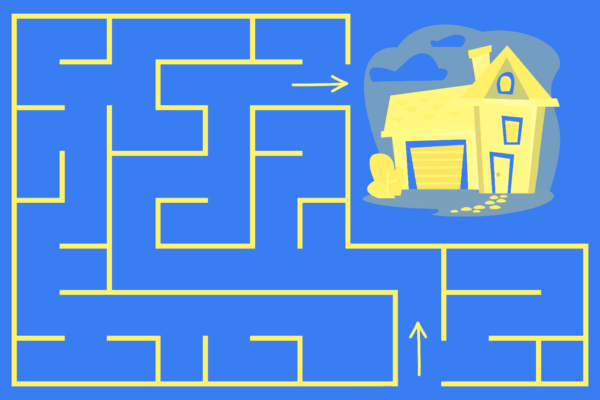
How Does Private Mortgage Insurance Work?

In 1989, the median down payment for all homebuyers was 20% of a home’s purchase price. By 2019, that number had dropped to only 12%. With today’s financing options, homebuyers can still get the home mortgage they need with smaller down payments. However, it comes with a catch. Borrowers planning on putting down less should be aware of private mortgage insurance— a lender requirement for those putting down less than 20% on a conventional mortgage.
Not sure what PMI, how it works, or whether you will need to purchase it? Here is everything you need to know.
What is private mortgage insurance?
Private mortgage insurance, commonly referred to as PMI, is mortgage insurance that lenders require borrowers to make if they make a down payment that is less than 20% of the home’s purchase price.
Whenever you make a small down payment, the amount that you borrow increases, which in turn increases the lender’s risk. The mortgage policy is designed to protect the lender— not the borrower— in the event that the borrower stops making payments, or defaults, on their loan. If the bank must foreclose on your house, PMI will help the lender recoup their losses, not the homeowner.
Loans That Require PMI
Not every loan will require private mortgage insurance, even if you make a small down payment.
Conventional loans, which aren’t backed by a government agency, most commonly require PMI. These are loans that are originated and serviced by private financial institutions like banks and credit unions. Other types of loans, such as FHA loans, don’t require PMI but may have other similar requirements.
You may find some conventional loans out there that don’t require PMI. These loans, however, often come with a much heftier interest rate.
Paying for Private Mortgage Insurance
There are three ways that your lender may have you pay for your private mortgage insurance: with a monthly premium, up-front premium, or an up-front and monthly premium.
- Paying monthly: If you pay your PMI premium monthly, it will simply be added to your monthly mortgage payment.
- Paying a one-time up-front premium: Instead of paying monthly, some lenders may require a larger, up-front PMI premium. This will be paid at closing.
- Paying up-front and monthly: With some lenders, you may be required to pay an upfront premium at closing and monthly.
With some lenders or loans, you will have the option of which way you would prefer to pay; with other lenders or loans, you may not.
When you apply for a mortgage, you will receive a Loan Estimate and Closing Disclosure. On page 1, under the “Projected Payment” section, you will be able to see the impact that any monthly premium payments will have on your overall mortgage payment. On page 2, in Section B, you can see what up-front premiums will be required at closing.
Private Mortgage Insurance Cost
PMI costs anywhere between 0.3% and 1.5% of your loan’s balance annually. This yearly amount is broken down into monthly payments, which makes paying it more manageable. According to Freddie Mac, you can expect to pay approximately between $30 and $70 per month, per every $100,000 borrowed.
Keep in mind that, like other types of insurance, PMI rates can go up over time.
How to Avoid PMI
The two most obvious ways to get around paying PMI are to simply put down more than 20% as a down payment or to go with a loan option that doesn’t require PMI.
Another way is to obtain what is referred to as a “piggyback loan”. With a piggyback loan, you’ll take out your primary mortgage that covers 80% of the purchase price, thus avoiding PMI. You’ll then take out a second loan to cover the remaining amount not covered by the down payment. Typically, piggyback loans are 80/10/10, meaning that your first mortgage will be 80%, the second loan will cover 10%, and your down payment will comprise the other 10% of the home’s purchase price.
Keep in mind that a second loan is not always easy to qualify for and that it comes with its own added risks. It may also affect your ability to use your home’s equity later on.
How to Get Rid of Private Mortgage Insurance
The good news is that if you do end up having to pay for private mortgage insurance, you won’t have to for the entire duration of your loan. There are a few ways to end your PMI obligations:
1. Request to cancel PMI at 20% equity.
Once your balance reaches 80% of the home’s original purchase price— in other words, you’ve built 20% equity in your house— you can contact your lender and request to stop paying for private mortgage insurance.
2. Wait for your PMI to automatically cancel at 22% equity.
Once you’ve paid off 22% of your house, your lender will automatically stop collecting PMI payments. The Homeowner Protection Act requires lenders to drop PMI when your balance reaches 78% of the home’s original purchase price.
3. Get your home reappraised.
When home improvements, neighborhood improvements, or market conditions increase the value of your home, it also increases the value of the equity you have. In some cases, a rise in value might be enough to boost the value of your equity above the required threshold for PMI.
Here’s an example. You bought a house several years ago for $200,000. Your current loan balance sits at $170,000.
Old appraised value: $200,000
Loan balance: $170,000
Current equity: 15%
Percentage of home value owed: 85%
But, if you get your home reappraised, you might learn that your house’s value has gone up by $50,000.
New appraised value: $250,000.
Loan balance: $170,000
New equity: 32%
New percentage of home value owed: 68%
Because what you owe doesn’t change, the amount of house that you own increases. But be careful—an appraisal that shows your value going down can mean that you’ve lost equity in your home.
4. Refinance your home.
Like the home reappraisal, eliminating your PMI with financing only works if your home has increased in value enough to bring what you owe to less than 80% of the home’s worth. It’s also important that you’re also getting a better deal on your interest rate, or else you can end up paying more in the long run. Use a mortgage refinance calculator to weigh your options.
A Part of Homeownership
For many, PMI is an unavoidable part of homeownership. Though private mortgage insurance can allow you to obtain a loan without having a ton of cash on hand for a down payment, it does come with a price. The insurance, which is designed to protect lenders, will cost you until you are able to build at least 20% equity in your home. Luckily, you won’t be trapped paying it forever, and you can even find ways to get to where you need to be sooner.
Looking for a mortgage lender?
Learn more about Amplify’s mortgage loans, and apply today!



